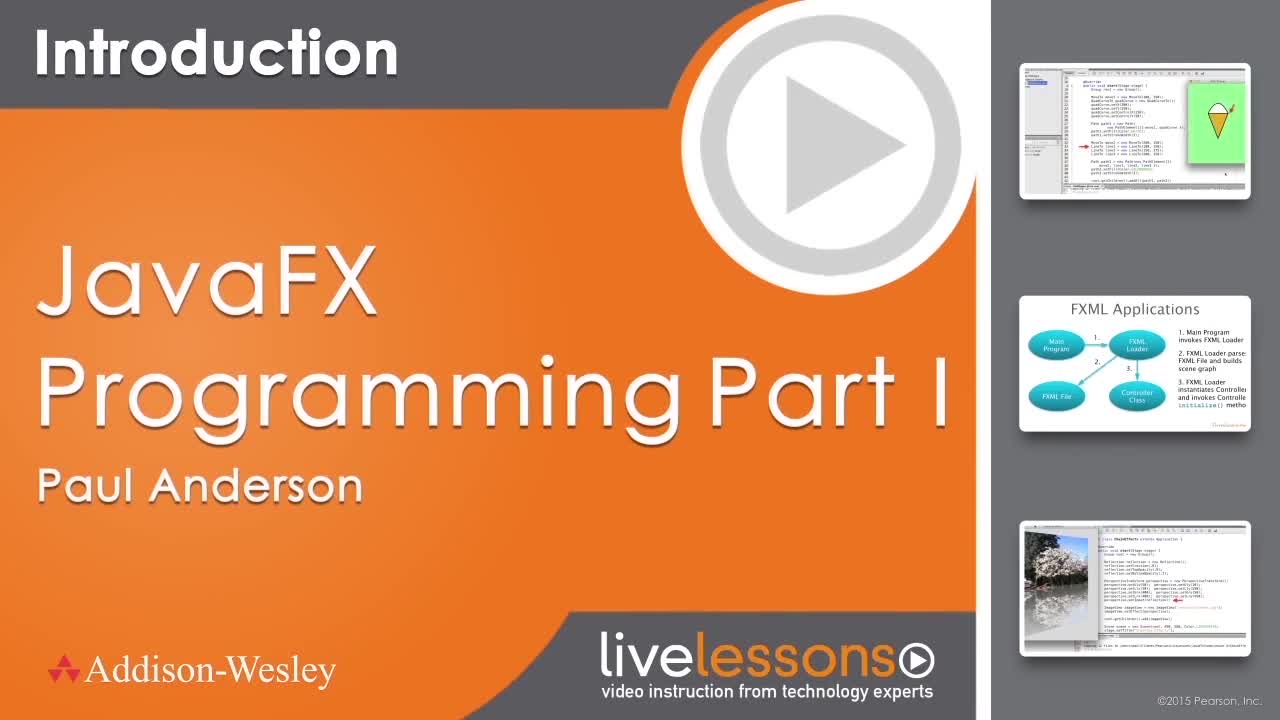JavaFX Programming LiveLessons, Part I (Video Training), Downloadable Version
- By Paul Anderson
- Published Jan 28, 2015 by Addison-Wesley Professional. Part of the LiveLessons series.
Downloadable Video
- Sorry, this book is no longer in print.
- About this video
Accessible from your Account page after purchase. Requires the free QuickTime Player software.
Videos can be viewed on: Windows 8, Windows XP, Vista, 7, and all versions of Macintosh OS X including the iPad, and other platforms that support the industry standard h.264 video codec.
Register your product to gain access to bonus material or receive a coupon.
Description
- Copyright 2015
- Edition: 1st
- Downloadable Video
- ISBN-10: 0-321-91872-X
- ISBN-13: 978-0-321-91872-7
9+ Hours of Video Instruction
Overview
Oracle is encouraging Java developers to migrate from Swing to JavaFX for GUI and rich client development. This video helps developers learn JavaFX and how to apply JavaFX effectively in Java applications.
Description
JavaFX Programming, Part I LiveLessons is organized into lessons that teach major JavaFX features with separate sublessons that demonstrate how to apply each feature. You’ll learn how to draw JavaFX shapes and apply effects to create a richer user experience on the desktop. You’ll learn how to use layout managers with GUI controls and menus. You’ll learn how to use JavaFX properties and binding expressions to simplify event handling and reduce Java code. You’ll also learn how to create animations with JavaFX in this video.
All lessons walk viewers through JavaFX code examples to reinforce the important concepts. The viewer also learns how to use the new JavaFX 8 features on the Java SE 8 platform and above.
About the Instructor
Paul L. Anderson is a founding member and Director of Training at the Anderson Software Group, Inc. (www.asgteach.com). Paul obtained his Bachelor of Arts degree from the University of California, San Diego, and his Master's degree in Electrical Engineering (MSEE) from the University of California, Santa Barbara. Mr. Anderson has taught Java, JavaFX, C++, C#, Perl, Python, UML, and Linux courses for thousands of developers and specializes in making software engineering fun and understandable. He has taught courses internationally in Europe and Latin America and contributed articles to InformIT. Paul is a member of the NetBeans Dream Team and has been a featured speaker at JavaOne conferences. He is also the co-author of 8 books on programming technologies and is the video instructor for the Java Reflection LiveLessons.
Paul is the co-author of JavaFX Rich Client Programming on the NetBeans Platform from Addison-Wesley. http://www.informit.com/store/javafx-rich-client-programming-on-the-netbeans-platform-9780321927712
Skill Level
- Beginner
- Intermediate
Learn How to:
- Design JavaFX applications
- Use graphics with JavaFX
- Design GUI apps with JavaFX layout components and controls
- Use bindings and properties in JavaFX
- Use animations, transitions, and effects in JavaFX
Who Should Take This Course
- Java developers who want to learn JavaFX for GUI development
- All Java developers who want to use JavaFX
- Swing developers who want to build great-looking applications with JavaFX
Course Requirements
Some experience programming in Java.
Table of Contents
Introduction
Lesson 1: Getting Started with JavaFX
Learning Objectives
1.1 Create a JavaFX program
1.2 Use FXML with JavaFX
Lesson 2: JavaFX Shapes
Learning Objectives
2.1 Use Color, Text, and Font
2.2 Use CSS Styling
2.3 Use Line, Circle, and Rectangle
2.4 Use LinearGradient and RadialGradient
2.5 Use Ellipse, Polygon, and Polyline
2.6 Use Arc, QuadCurve, and CubicCurve
2.7 Use Path and PathElement
Lesson 3: JavaFX Effects
Learning Objectives
3.1 Use Shadow, DropShadow, and InnerShadow
3.2 Use BoxBlur, GaussianBlur, and MotionBlur
3.3 Apply Blend, Bloom, and Glow
3.4 Add Lighting
3.5 Use ColorAdjust, ColorInput, and ImageInput
3.6 Apply Reflection and SepiaTone
3.7 Apply DisplacementMap and PerspectiveTransform
3.8 Create a Chain of Effects
Lesson 4: JavaFX Layout Components
Learning Objectives
4.1 Use Region and Pane
4.2 Use HBox and VBox
4.3 Understand FlowPane and TilePane
4.4 Understand GridPane
4.5 Understand StackPane
4.6 Understand BorderPane
4.7 Understand AnchorPane
4.8 Use TextFlow
Lesson 5: JavaFX Properties and Bindings
Learning Objectives
5.1 Understand Beans and Properties
5.2 Understand Listeners
5.3 Use Unidirectional Binding
5.4 Use Bidirectional Binding
5.5 Use Factory Binding
5.6 Use Fluent Binding
5.7 Use Custom Binding
Lesson 6: Basic JavaFX Controls
Learning Objectives
6.1 Understand Event Handlers
6.2 Use Label and Button
6.3 Use RadioButton and ToggleButton
6.4 Use CheckBox, ChoiceBox, and ComboBox
6.5 Use TextField and PasswordField
6.6 Use ScrollBar and Slider
6.7 Use ProgressBar and ProgressIndicator
6.8 Use TextArea
6.9 Use Hyperlink and ToolBar
Lesson 7: Composite JavaFX Controls
Learning Objectives
7.1 Navigate the Control Hierarchy
7.2 Build Menus
7.3 Use ContextMenu and Tooltip
7.4 Use ColorPicker and DatePicker
7.5 Use ListView and TreeView
7.6 Use TableView and TreeTableView
7.7 Use SplitPane and TabPane
7.8 Use TitledPane and Accordion
7.9 Use ScrollPane and Pagination
7.10 Use HTMLEditor
Lesson 8: JavaFX Animation
Learning Objectives
8.1 Understand Transitions
8.2 Use FadeTransition
8.3 Use FillTransition
8.4 Use StrokeTransition
8.5 Use ScaleTransition
8.6 Use TranslateTransition
8.7 Use RotateTransition
8.8 Use PathTransition
8.9 Use PauseTransition
8.10 Use SequentialTransition
8.11 Use ParallelTransition
Summary
About LiveLessons Video Training
LiveLessons Video Training series publishes hundreds of hands-on, expert-led video tutorials covering a wide selection of technology topics designed to teach you the skills you need to succeed. This professional and personal technology video series features world-leading author instructors published by your trusted technology brands: Addison-Wesley, Cisco Press, IBM Press, Pearson IT Certification, Prentice Hall, Sams, and Que. Topics include: IT Certification, Programming, Web Development, Mobile Development, Home and Office Technologies, Business and Management, and more. View all LiveLessons on InformIT at: http://www.informit.com/livelessons
More Information

